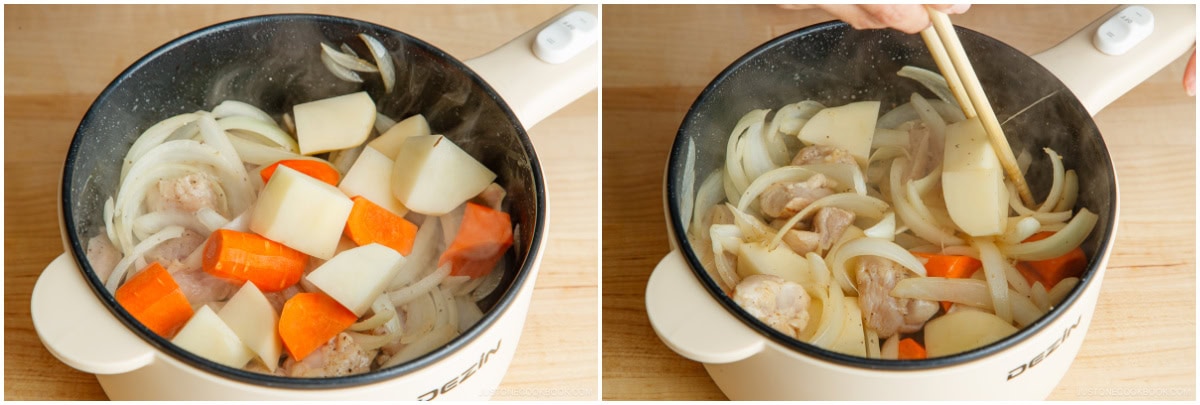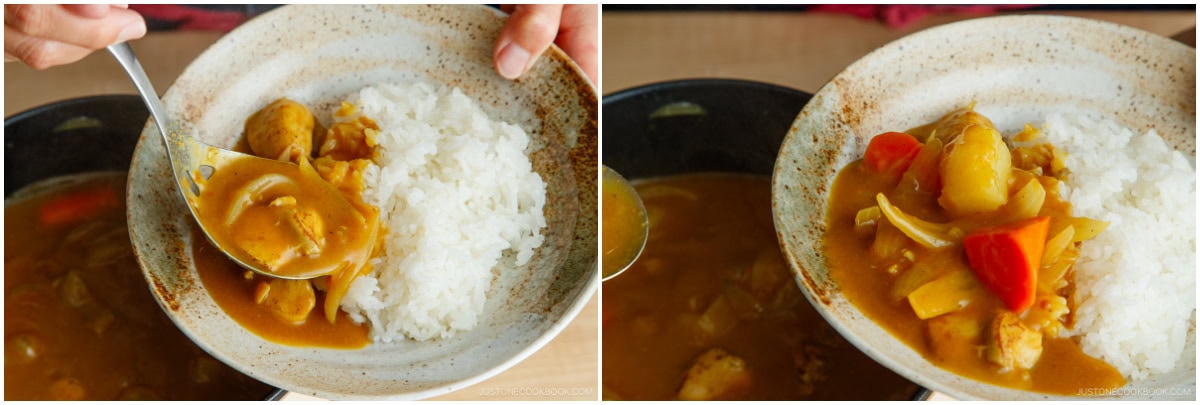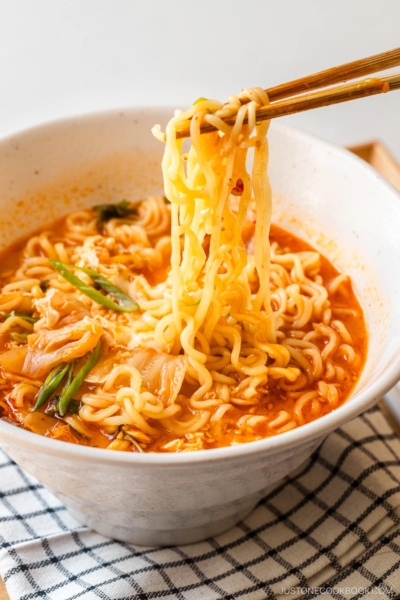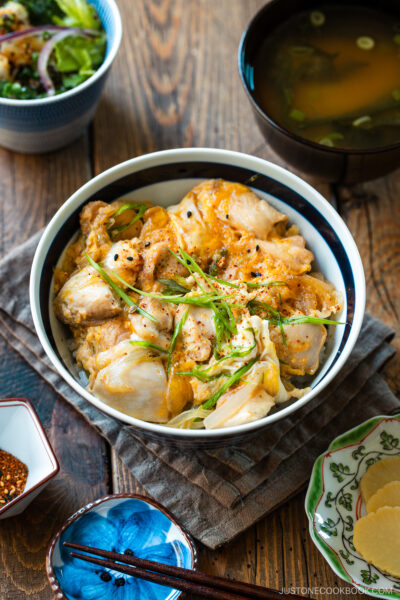Make this Easy Japanese curry in just 20 minutes! This quick yet flavorful recipe for chicken curry rice is perfect for anyone who does small-batch cooking.

Cooking the iconic Japanese curry typically requires some simmering time, but what if I told you that you can now make it in just 20 minutes, especially with a Dezin Electric Cooker?
My son, who is now a freshman in college, jumped for joy when I taught him how to make the curry using this versatile pot. He was astonished by how easy it was and was proud that he could make a great pot of curry on his own!
This recipe is designed for our Easy College Meal Series and will be handy on cooler days or when you have a curry craving.
Table of Contents

Japanese Curry at a Glance
“Best curry I’ve ever had. This recipe is so detailed and is so easy to follow.”
Japanese curry, alongside sushi and ramen, is one of my most popular recipes on Just One Cookbook! We consider Japanese curry a cornerstone dish of Japanese home cooking. Many readers, including those new to making curry, have had great success.
With mild sweetness from vegetables, layered fragrance from the curry roux, and a creamy richness that will warm you right up, Japanese curry is indeed one-of-a-kind. I often describe it as the best beginner-friendly curry to introduce to kids and adults who can’t tolerate heat. That said, it is a must-try for every curry enthusiast!
🍛 You can read about its origin and get in-depth cooking tips in my original recipe (ideal for big batches), but if you wish to cook the curry quickly in a smaller portion, this recipe is for you!
Why You’ll Enjoy this Easy Japanese Curry
- A fantastic recipe for portable cooking! Besides dorm cooking, this one-pot curry is a great dish to prepare if you’re looking for Japanese camping foods, especially in the fall or winter. If you have access to a power outlet, plug in the cooker, toss in the prepped ingredients, and within 15 minutes, a fragrant pot of curry will be ready for you to devour!
- Easy-to-access ingredients (including the curry roux!). These days, Japanese curry roux packages are available on Amazon and in major American grocery stores (finally!). There are even different spice levels to choose from. I used to cook with the ‘Mild’ option when my children were small, but now my family enjoys the ‘Medium Hot’ level.”

Ingredients for Easy Japanese Curry
- Onions
- Carrots
- Potatoes (Yukon gold or Russet)
- Boneless, skinless chicken thigh — see below for substitutions
- Freshly ground black pepper, salt, oil, water
- Japanese curry roux
- Japanese steamed rice for serving
- Fukujinzuke (Japanese curry condiment) (optional)
Substitutions
- Chicken — You can substitute the chicken with beef, shrimp, seafood, mushrooms, other vegetables, and tofu. If you use tofu, you just need to warm it up, as it’s already fully cooked. I recommend draining tofu for 15 minutes before use, as it contains lots of moisture. Add the drained tofu to the curry for 3 minutes to warm it up.

How to Make Easy Japanese Curry
- Cut the ingredients. Cut the onion, carrot, potato, and chicken thigh. Season the chicken with salt and black pepper.
- Cook ingredients. Start cooking the onion until slightly tender, then add the chicken. Coat the carrots and potatoes with oil. Then, add the water and simmer for 13 minutes.
- Add the curry roux and serve.
Recipe Tips
- Cut ingredients into uniform shapes so they cook evenly.
- Make sure all ingredients are fully submerged in the cooking water. Use a spatula to push them down before covering the pot with a lid.
- Keep a few bamboo skewers in the kitchen. They’re handy for both cooking and baking. I use them to check the doneness of potatoes and cakes.
- Turn off the heat before dissolving the curry roux. Thick roux can burn easily at the bottom of the pot if you’re not careful. I recommend turning off the heat when adding the curry roux, then turning it back on to thicken the curry. With heat, the curry will naturally thicken in just a few minutes.
- Dissolve the curry roux inside a ladle until it fully melts. This will prevent chunks of roux from floating in the curry.

How to Store
- To Refrigerate: I recommend storing leftovers in a glass airtight container (to avoid stains!) and keeping them in the refrigerator for up to 3 days.
- To Freeze: Store leftovers in a glass airtight container, removing the potatoes, as their texture will change. Defrost the frozen curry in the refrigerator for 24 hours before serving. Stir in a bit of water to loosen the thickened sauce, then gently reheat on low heat, stirring frequently to avoid burning the sauce.
- To Reheat: Gently reheat on low heat on the stove, or cover your bowl and reheat in the microwave.
Easy College Meal Series
I started this College Meal Series for my son, who started college this fall, but I hope it will benefit anyone who needs comforting recipes that are easy to make.
We use this Dezin Electric Cooker to cook many of his favorite dishes, and it has been a lifesaver! You can still use your saucepan or frying pan for these recipes if you don’t feel the need to get the cooker.
Here are the recipes we’ve shared for the Series so far:
Please check back for more! Also, don’t miss the video where my son will show you how to make Japanese curry on Instagram!

Easy Japanese Curry
Video
Ingredients
- ½ onion (5 oz, 140 g; peeled)
- ½ carrot (3.2 oz, 90 g; roughly 3 inches)
- ½ russet potato (¼ lb, 130 g)
- 5 oz boneless, skinless chicken thigh (roughly 1 thigh; use plant-based meat substitute for vegan/vegetarian)
- ⅛ tsp freshly ground black pepper
- ⅛ tsp Diamond Crystal kosher salt
- 1 Tbsp neutral oil
- 2 cups water
- 2 cubes Japanese curry roux (about 2 oz, 55 g)
For Serving
- 1 serving cooked Japanese short-grain rice (see how to cook rice in a rice cooker, pot over the stove, Instant Pot, or donabe)
- fukujinzuke (Japanese red pickled vegetables) (optional)
Instructions
- Gather all the ingredients. I use an electric pot for this recipe and others in the 10-Minute Meal series. You also could use a regular saucepan on the stove.

- Use a knife to cut ½ onion into thin slices.

- Peel ½ carrot (I love using my Japanese peeler). Then, cut it in a rangiri shape by rotating the carrot a quarter turn between diagonal cuts. The rangiri Japanese cutting technique creates an attractive shape with more surface area to absorb the seasonings.

- Peel ½ russet potato and cut it into small chunks about 1 inch (2.5 cm) wide.

- Cut 5 oz boneless, skinless chicken thigh into bite-size pieces, about 1 inch (2.5 cm) square. To do so, cut the chicken along the grain into strips 1 inch (2.5 cm) wide. Then, angle your knife back diagonally and slice the chicken strips against the grain into flat pieces. This Japanese cutting technique called sogigiri creates pieces of equal thickness and more surface area for faster cooking and better flavor absorption.

- Season the chicken pieces with ⅛ tsp freshly ground black pepper and ⅛ tsp Diamond Crystal kosher salt.

To Cook
- Turn on the heat to medium-high on the stove or Mode II (600W) on the electric pot. Add 1 Tbsp neutral oil to the pot. When the oil is hot, add the onions.

- Cook the onions until tender and slightly charred.

- Add the chicken and stir to cook until it is no longer pink on the outside.

- Add the carrots and potatoes and coat them with the oil. Tip: Coating with oil seals in the nutrients and flavor and prevents the vegetables from breaking apart.

- Add 2 cups water. Level the ingredients so they are completely submerged under the water.

- Cover with a lid and cook for 13 minutes.

- Check for doneness. If a wooden skewer pierces a potato and carrot easily, it's done cooking. Turn off the heat. Add one of the 2 cubes Japanese curry roux to a ladle (I use a draining ladle) along with some cooking liquid. Completely dissolve the roux in the liquid with chopsticks before stirring it into the pot.

- Repeat with the remaining cube of roux.

- Turn on the heat again, this time to medium or Mode I (250W). Let the curry sauce thicken, stirring frequently so that it does not burn on the bottom of the pot. Turn off the heat once the curry is an ideal consistency, about 2–3 minutes.

To Serve
- Add 1 serving cooked Japanese short-grain rice to one half of an individual bowl or curry plate and ladle the Japanese curry on the other half. Serve with optional fukujinzuke (Japanese red pickled vegetables).

To Store
- Keep any leftovers in an airtight glass container (so no stains!) and store in the refrigerator for up to 3 days or in the freezer for a month. Remove the potatoes before freezing, as their texture will change. Defrost the frozen curry in the refrigerator for 24 hours before you want to serve it. Stir in a bit of water to loosen the thickened sauce, then gently reheat on low heat, stirring frequently to avoid burning the sauce.








This is one of my favourites, with or without chicken. Sometimes I have a different protein.
Cos I keep the curry pack in the freezer, I found it worked better to grate the cubes in.
Hi Trish! We are glad to hear you enjoyed Nami’s recipe!
Thank you so much for trying her recipe and sharing your tips and experiences! Happy Cooking!🤗
My wife and I decided to make this for dinner tonight. I must say, we’ve thoroughly enjoyed several recipes from your site, such as the chicken curry, which we sometimes alter to make vegetarian, the beef curry, the beef bowl, and, a personal favourite, the tonkatsu. While looking for a meal to make, we were incredulous at the short preparation time that this recipe claimed– only 15 minutes! It usually takes me between 1:30 and 2 hours to make your chicken curry, which we had thought about making but deemed it too late in the evening for such a large meal. I reckoned that it would be impossible to complete a curry in such a short time, but decided to give it my best shot. We set a timer, and worked fast. Even though I skipped a few steps, such as not peeling my potatoes, the prep work still took me about 15 minutes, and then another 25 for the cooking. All told it was ready to eat after no more than 45 minutes after we started the timer, which is quite fast, in my book: certainly not quite 15 minutes, but definitely faster than I’ve ever made this curry before, and it tastes just the same as the “longer” chicken curry recipe.
It is a much smaller size than a full pot of curry, I made it in a smaller pot and it will be just about the perfect amount to serve the both of us with no leftovers, which has both upsides and downsides– Usually, I make enough to freeze 6 or so extra portions for later meals! But, that smaller size definitely made prep and cooking much faster. I did “double” the vegetables, cutting up a whole onion, carrot and potato, and I probably added around 250g of chicken rather than 140g, so that likely increased the cook time slightly. I also added a bit of low-salt chicken bouillon to the water, as is done in the “full” chicken curry recipe. None of the other measurements needed any adjustment, though.
I did find that I needed to add a bit of water part-way through the cooking time, as the vegetables were no longer covered. I think this is because I left the element on medium-high even after bringing the water to a boil, even though I would normal turn it down to simmer. I did that in an effort to follow the instructions as closely as possible, not making any modifications that might increase the cooking time. However, this was a mistake– Water can never be above 100 degrees C at atmospheric pressure! Because we are all victims of physics, any extra energy added to water once it’s at it’s boiling point will only serve to boil the water *faster*, not raise the temperature above 100 degrees. So, by failing to turn the stove down while the veggies simmered, I probably added 5 or so minutes to my total cook time, since when I added the water a second time, the pot had to come back up to temp. I should have thought back to my thermodynamics class!
Even though this was a pretty fast meal, I think that I’ll probably stick to making curry the “slow” way for the most part. I think I generally value the leftovers that I can put in the freezer, over the shorter cooking and prep time. Still, I’m glad to have tried it and been pleasantly surprised by how fast I was able to make this favourite meal.
Hello Dallin, Thank you for trying Nami’s recipe and sharing your experiences with us!
If I was to replace the curry cubes with S&B curry powder, how much would I use ? Thank you. Love your site 🙂
Hello, Leslie. Thank you for trying Nami’s recipe.
If you prefer curry powder, we recommend making a homemade roux cube. Because curry powder alone would not produce the same curry texture and flavor.
Here’s the recipe.
https://www.justonecookbook.com/how-to-make-curry-roux/
Thanks you for the JOC Goods link (hope you get a percentage) … love the site … most appreciated!
Hi Perry! Thank you so much for your kind feedback!
We hope you enjoy cooking and shopping with JOC. Thank you for your love and support! 💞🫶🏻
Been using Golden Curry for 40 years, the one tip I’ve taught my kids is TO READ THE DIRECTIONS ON THE BOX. The most important one is to remove the pot from the heat, THEN stir in the roux. That way it never burns. However, my fondest childhood memories revolve around my Okasan having a pot ready after school that she made the old way, simmered for quite some time, a labor of love.
Hello, JiiJii. Thank you for reading Nami’s post and sharing your childhood memories. It was heartwarming.🥰
Something interesting I learned about packaged curry roux in my high school Japanese club, is to cut it up into small pieces so it dissolves easier! Then one of my parents had the idea to grate it!
Hello Claire! That is also a great idea. Thank you for reading Nami’s post and sharing it!